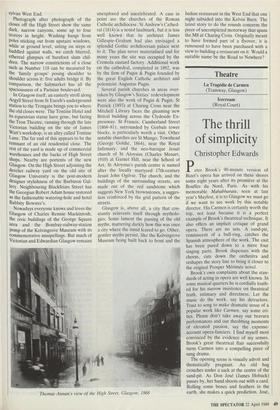Architecture
Old Closes and Streets of Glasgow (Portrait Gallery, Edinburgh, till 7 July)
In search of old Glasgow
James McGeachie
Ahaunting introduction to the prehis- tory of Europe's prospective cultural capit- al of 1990 is currently on display at the Portrait Gallery, Queen Street, Edin- burgh. In 1868, before demolishing the squalid old closes that lay between the High Street, the Trongate and the Saltmar- ket, the city fathers of Glasgow commis- sioned Thomas Annan, a local landscape photographer, to make a pictorial record of the area. The exhibition takes us from the Tontine Hotel, adjacent to the 17th- century Tollbooth Steeple and fronted by an equestrian statue, to a bleak High Street with a pawnbroker's sign symbolically in the foreground. This was also the period when the surge of industry and population led to the abandonment of the area by Glasgow University. By 1870 the university of Adam Smith had been relocated in Giles Gilbert Scott's Gothic palace in the more sylvan West End.
Photograph after photograph of the Closes off the High Street show the same dark, narrow canyons, some up to four storeys in height. Washing hangs from Poles sticking out from upstairs windows, While at ground level, sitting on steps or huddled against walls, we catch blurred, ethereal glimpses of barefoot slum chil- dren. The narrow constrictions of a close such as Number 118 can be measured by the 'family groups' posing shoulder to shoulder across it: five adults bridge it. By comparison, the Saltmarket has all the Spaciousness of a Parisian boulevard.
In Glasgow itself, an easterly stroll along Argyll Street from St Enoch's underground station to the Trongate brings you to where the old closes were. The Tontine Hotel and its equestrian statue have gone, but facing the Tron Theatre, running through the late Victorian building on the site of James Watt's workshop, is an alley called Tontine Lane. The far end of this appears to be the remnant of an old residential close. The rest of the yard is made up of commercial warehouses and the backs of High Street Shops. Nearby are portents of the new Glasgow. On the High Street adjoining the derelict railway yard on the old site of Glasgow University is the post-modern designer stylishness of the Barbizon Gal- lery. Neighbouring Blackfriars Street has the Georgian Robert Adam house restored as the fashionable watering-hole and hotel Babbity Bowster's.
Nowadays everyone knows and loves the Glasgow of Charles Rennie Mackintosh, the civic buildings of the George Square area and the Bombay-railway-station Pomp of the Kelvingrove Museum with its Commemorative misspellings. But much of Victorian and Edwardian Glasgow remains unexplored and uncelebrated. A case in point are the churches of the Roman Catholic archdiocese. St Andrew's Cathed- ral (1814) is a noted landmark, but it is less well known that its architect James Gillespie-Graham had also envisaged a splendid Gothic archdiocesan palace next to it. The plan never materialised and for many years the site was occupied by the Cremola custard factory. Additional work on the cathedral, completed in 1892, was by the firm of Pugin & Pugin founded by the great English Catholic architect and polemicist Augustus Pugin. Several parish churches in areas over- taken by Glasgow's Sixties' redevelopment were also the work of Pugin & Pugin. St Patrick (1893) at Charing Cross near the Mitchell Library faces the gleaming new Britoil building across the Clydeside Ex- pressway. St Francis, Cumberland Street (1868-81), surrounded by Gorbals tower blocks, is particularly worth a visit. Other notable churches are St Mungo, Townhead (George Goldie, 1864), near the Royal Infirmary, and the neo-baroque Jesuit church of St Aloysius (Charles Menart, 1910) at Garnet Hill, near the School of Art. St Aloysius's parish centre is named after the locally martyred 17th-century Jesuit John Ogilvie. The church, and the buildings of the surrounding streets, are made out of the red sandstone which suggests New York brownstones, a sugges- tion reinforced by the grid pattern of the streets.
Glasgow is, above all, a city that con- stantly reinvents itself through mytholo- gies. Some lament the passing of the old myths, muttering darkly how this was once a city where the timid feared to go. Other, gentler myths persist, like the Kelvingrove Museum being built back to front and the
Thomas Anima's view of the High Street, Glasgow, 1868
Indian restaurant in the West End that one night subsided into the Kelvin Burn. The latest story to do the rounds concerns the piece of uncompleted motorway that spans the M8 at Charing Cross. Originally meant to have formed part of a flyover, it is rumoured to have been purchased with a view to building a restaurant on it. Would a suitable name be the Road to Nowhere?



































































 Previous page
Previous page